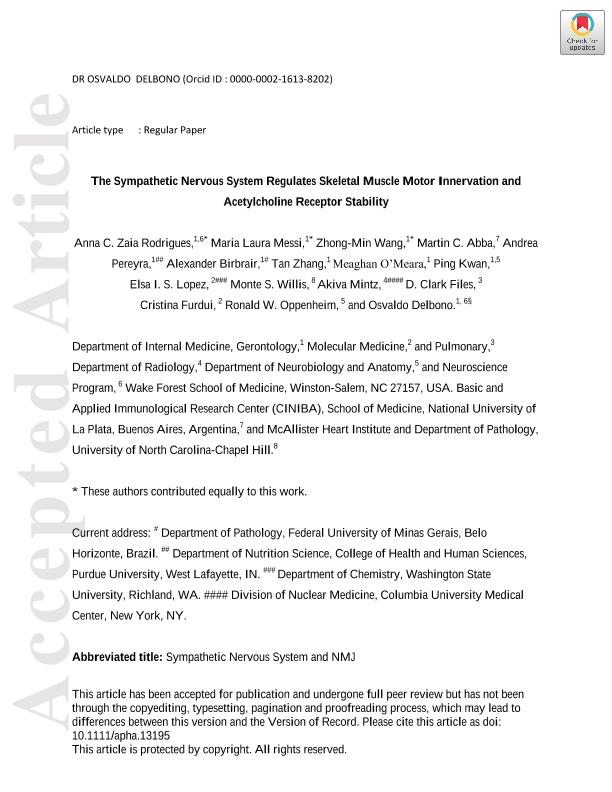Artículo
The sympathetic nervous system regulates skeletal muscle motor innervation and acetylcholine receptor stability
Rodrigues, Anna C. Zaia; Messi, Maria Laura; Wang, Zhong Min; Abba, Martín Carlos ; Pereyra, Andrea Soledad
; Pereyra, Andrea Soledad ; Birbrair, Alexander; Zhang, Tan; O´Meara, Meaghan; Kwan, Ping; Lopez, Elsa I. S.; Willis, Monte S.; Mintz, Akiva; Files, D. Clark; Furdui, Cristina; Oppenheim, Ronald W.; Delbono, Osvaldo
; Birbrair, Alexander; Zhang, Tan; O´Meara, Meaghan; Kwan, Ping; Lopez, Elsa I. S.; Willis, Monte S.; Mintz, Akiva; Files, D. Clark; Furdui, Cristina; Oppenheim, Ronald W.; Delbono, Osvaldo
 ; Pereyra, Andrea Soledad
; Pereyra, Andrea Soledad ; Birbrair, Alexander; Zhang, Tan; O´Meara, Meaghan; Kwan, Ping; Lopez, Elsa I. S.; Willis, Monte S.; Mintz, Akiva; Files, D. Clark; Furdui, Cristina; Oppenheim, Ronald W.; Delbono, Osvaldo
; Birbrair, Alexander; Zhang, Tan; O´Meara, Meaghan; Kwan, Ping; Lopez, Elsa I. S.; Willis, Monte S.; Mintz, Akiva; Files, D. Clark; Furdui, Cristina; Oppenheim, Ronald W.; Delbono, Osvaldo
Fecha de publicación:
03/2019
Editorial:
Wiley Blackwell Publishing, Inc
Revista:
Acta Physiologica
ISSN:
1748-1708
Idioma:
Inglés
Tipo de recurso:
Artículo publicado
Clasificación temática:
Resumen
Aim: Symptoms of autonomic failure are frequently the presentation of advanced age and neurodegenerative diseases that impair adaptation to common physiologic stressors. The aim of this work was to examine the interaction between the sympathetic and motor nervous system, the involvement of the sympathetic nervous system (SNS) in neuromuscular junction (NMJ) presynaptic motor function, the stability of postsynaptic molecular organization, and the skeletal muscle composition and function. Methods: Since muscle weakness is a symptom of diseases characterized by autonomic dysfunction, we studied the impact of regional sympathetic ablation on muscle motor innervation by using transcriptome analysis, retrograde tracing of the sympathetic outflow to the skeletal muscle, confocal and electron microscopy, NMJ transmission by electrophysiological methods, protein analysis, and state of the art microsurgical techniques, in C57BL6, MuRF1KO and Thy-1 mice. Results: We found that the SNS regulates motor nerve synaptic vesicle release, skeletal muscle transcriptome, muscle force generated by motor nerve activity, axonal neurofilament phosphorylation, myelin thickness, and myofibre subtype composition and CSA. The SNS also modulates the levels of postsynaptic membrane acetylcholine receptor by regulating the Gα i2 -Hdac4-Myogenin-MuRF1pathway, which is prevented by the overexpression of the guanine nucleotide-binding protein Gα i2 (Q205L), a constitutively active mutant G protein subunit. Conclusion: The SNS regulates NMJ transmission, maintains optimal Gα i2 expression, and prevents any increase in Hdac4, myogenin, MuRF1, and miR-206. SNS ablation leads to upregulation of MuRF1, muscle atrophy, and downregulation of postsynaptic AChR. Our findings are relevant to clinical conditions characterized by progressive decline of sympathetic innervation, such as neurodegenerative diseases and aging.
Archivos asociados
Licencia
Identificadores
Colecciones
Articulos(CCT - LA PLATA)
Articulos de CTRO.CIENTIFICO TECNOL.CONICET - LA PLATA
Articulos de CTRO.CIENTIFICO TECNOL.CONICET - LA PLATA
Citación
Rodrigues, Anna C. Zaia; Messi, Maria Laura; Wang, Zhong Min; Abba, Martín Carlos; Pereyra, Andrea Soledad; et al.; The sympathetic nervous system regulates skeletal muscle motor innervation and acetylcholine receptor stability; Wiley Blackwell Publishing, Inc; Acta Physiologica; 225; 3; 3-2019; 1-78
Compartir
Altmétricas



